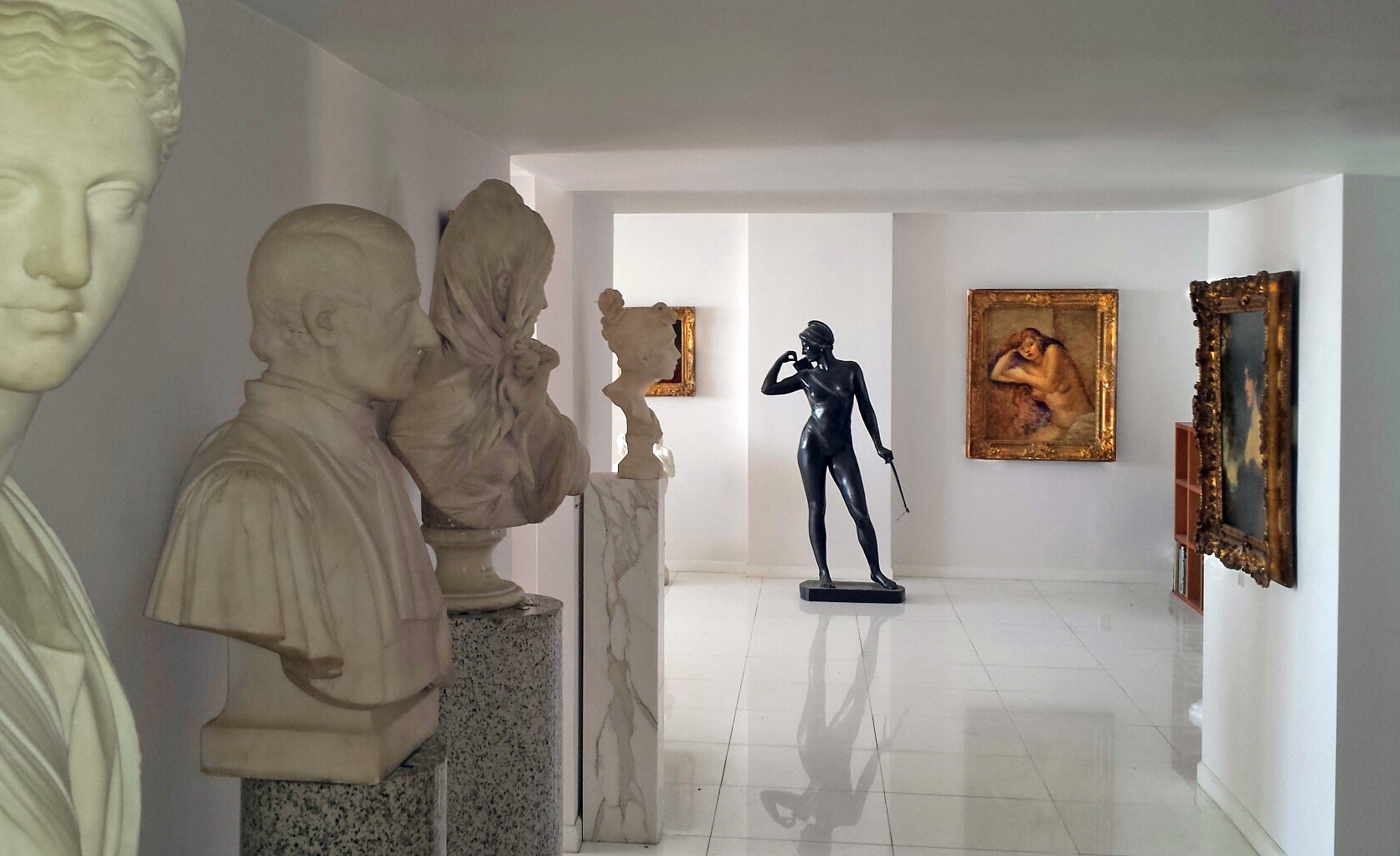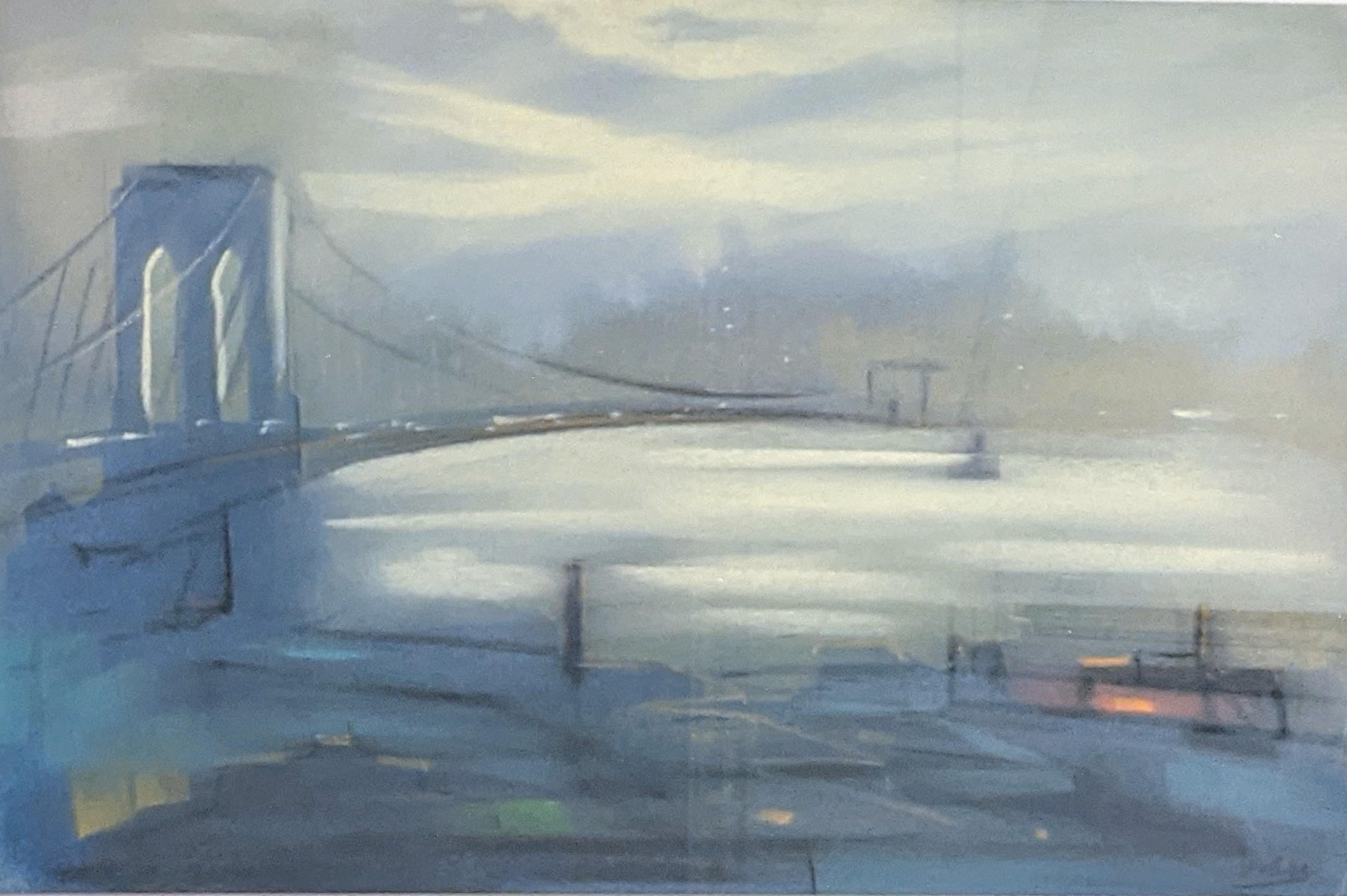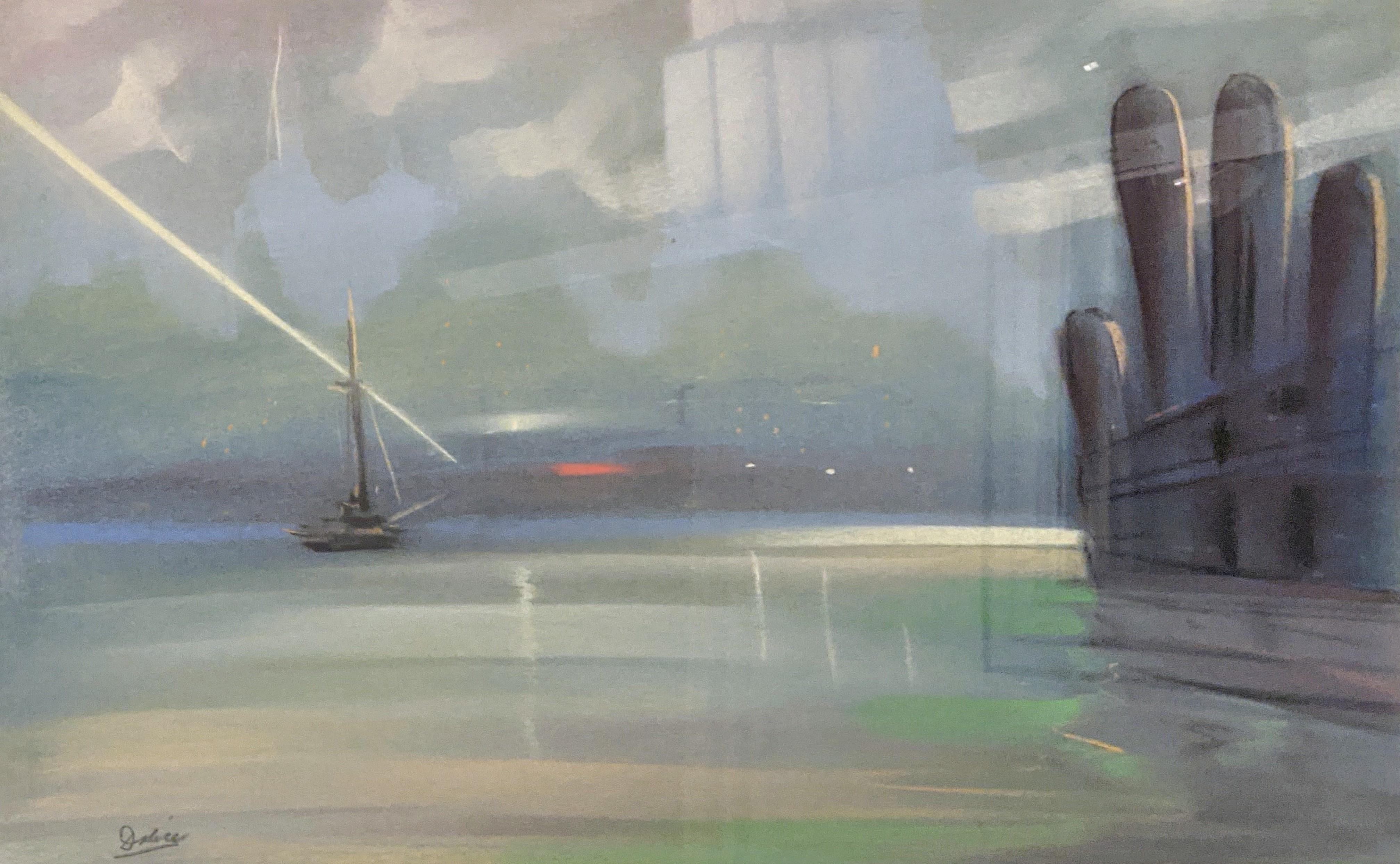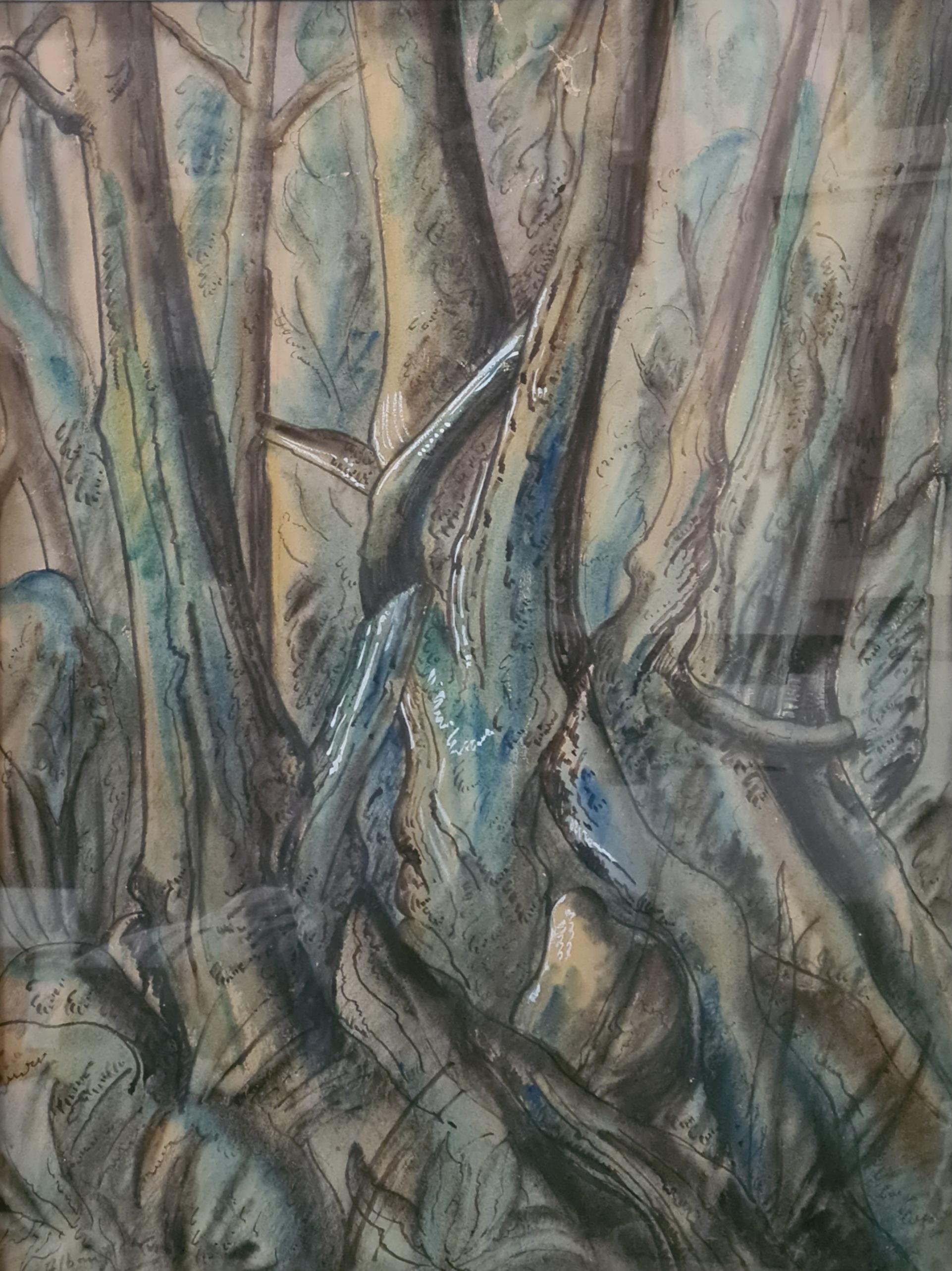Items Similar to Metropolitan Fantasy - City at Night with Pulsing Lights
Want more images or videos?
Request additional images or videos from the seller
1 of 16
Yvonne JacquetteMetropolitan Fantasy - City at Night with Pulsing Lights 1997
1997
About the Item
Yvonne Jacquette uses pastel on a heavy rag paper to depict an ariel city scene at night with pulsing lights. There is a heavy texture to the paper and the surface is rich and vibrant with color against a dark ground. It is beautifully framed in a heavy hardwood frame with a deep matt. Signed lower left: Jacquette
Property from the G.E. Corporate Art Collection - Framed under glass. Not examined out of frame. Slight undulation to the sheet.
Framed Dimensions 27.75 X 24 Inches
Conditon of art, matte and frame is very good and presents very well
- Creator:Yvonne Jacquette (1934, American)
- Creation Year:1997
- Dimensions:Height: 17.5 in (44.45 cm)Width: 14.25 in (36.2 cm)
- Medium:
- Movement & Style:
- Period:
- Condition:
- Gallery Location:Miami, FL
- Reference Number:1stDibs: LU38539741732

About the Seller
4.9
Platinum Seller
These expertly vetted sellers are 1stDibs' most experienced sellers and are rated highest by our customers.
Established in 2005
1stDibs seller since 2016
102 sales on 1stDibs
Typical response time: 1 hour
- ShippingRetrieving quote...Ships From: Miami, FL
- Return PolicyA return for this item may be initiated within 3 days of delivery.
More From This SellerView All
- New York Harbor with Ferry boats and Victorian Houses - Holiday Magazine CoverBy Saul SteinbergLocated in Miami, FLSteinberg's Holiday Magazine Cover, " The North of Jersey " is similar to his famous New Yorker Cover "View of the World from 9th Avenue”. ...Category
1950s American Modern Landscape Drawings and Watercolors
MaterialsIndia Ink
- Mediterranean Sailboats and Sleeping SailorsBy Walt LouderbackLocated in Miami, FLSigned lower right. Work is unframed. Very Slight fading commensurate with time but presents very well Biography Walt Louderback Walt Louderback (1887-1941) The illustrations of W...Category
1930s Post-Impressionist Landscape Drawings and Watercolors
MaterialsWatercolor
- Waldorf Astoria Art Deco IllustrationLocated in Miami, FLArtist Charles Perry Weimer employs thin black horizontal lines that intersect with thin black vertical lines. The result is a triumph of design w...Category
1930s Art Deco Landscape Drawings and Watercolors
MaterialsInk, Gouache, Pen
- Pool ShadowsBy Millard SheetsLocated in Miami, FLSigned M. Sheets lower left, Sheets is a masterful craftsman rooted in sound academic training but displays a loose post-impressionist style that does homage to Gaugain. Best viewed...Category
1970s Post-Impressionist Landscape Drawings and Watercolors
MaterialsPencil, Watercolor
- Hotel Futura IllustrationBy Joseph BinderLocated in Miami, FLMen Who Plan Beyond Tomorrow” Advertising campaign for The world’s incredible technological inventions that we take for granted today ….. Provenance: Edgar Bronfman Sr. former C...Category
1940s Futurist Landscape Paintings
MaterialsIllustration Board, Gouache
- Quebec City, Fauve LandscapeBy William ZorachLocated in Miami, FLWonderful Fauve Landscape with blocky areas of punchy bold reds and yellows. This was done the same year of the Armory Show in which both William Zor...Category
Early 20th Century Expressionist Landscape Paintings
MaterialsWatercolor
You May Also Like
- "Tokyo Diptych, " Yvonne Jacquette, Japanese Urban Cityscape Nocturnal AerialBy Yvonne JacquetteLocated in New York, NYYvonne Jacquette (American, b. 1935) Tokyo Diptych, 1985 Pastel on paper Overall 17 1/4 x 28 1/2 inches Signed lower center Provenance: Carey Ellis Company, Houston, Texas Brooke Alexander, New York Collection of an American Corporation Exhibited: New York, Brooke Alexander, Yvonne Jacquette: Tokyo Nightviews, April 5 - May 3, 1986, n.p., illustrated; this exhibition later traveled to Brunswick, Maine, Bowdoin College Museum of Art, Yvonne Jacquette: Tokyo Nightviews, June 27 - August 24, 1986. Yvonne Jacquette has a preference for high places, a circling plane, a penthouse window, an aerie from which to watch the world. Her work has often depicted the city and man-made landscape from the vantage of angels. It is a privileged perspective, long loved by photographers, who were perhaps the first to recognize the geometric grandeur of the city below. That grandeur structures Jacquette's images but is not its full content. Her work attempts to resolve the visual and emotional pardoxes of the modern metropolis. Only from the tower is there the possibility of order and context. And unlaced beauty. Jacquette first visited Japan in 1982. Nighttime Tokyo, its cars and crowds and canyons of loud Vegas neon, made a vivid and bewildering impression on her. The neon signs, pulsing, scaling the walls of high rises, fascinated the artist, "like Times Square spread over miles." Her fascination was equal parts marvel, confusion, and curiosity—the sparks of art. She returned to Tokyo in May of 1985, choosing hotel rooms with expansive vistas. From these views Jacquette excerpted images for a series of pastel night scenes. The basic forms and colors of each drawing were blocked in during night sessions by the window. She worked in the dark, selecting colors by flashlight. In daylight, she sharpened the geometry and corrected ambiguous passages. She refined the drawings further in the studio until the images read clearly. Photographic correctness was not important. The finished drawings are complete statements, not simply preparatory sketches for paintings. They have the authority of expert witness. In clear, discreet jots of pastel they record the performance of seeing, each touch of color attesting to a moment's close scrutiny. Yvonne Jacquette was born on December 15, 1934 in Pittsburgh, Pennsylvania and grew up in Stamford, Connecticut. She attended the Rhode Island School of Design, Providence from 1952 to 1955, when she moved to New York City. Her late husband was photographer Rudy Burckhardt, and the couple were part of a circle of artist friends that included Fairfield Porter, Alex Katz, Red Grooms, and Mimi Gross. She continues to live and work in New York City, as well as in Searsmont, Maine. A flight to San Diego in 1969 sparked Jacquette’s interest in aerial views, after which she began flying in commercial airliners to study cloud formations and weather patterns. She soon started sketching and painting the landscape as seen from above, beginning a process that has developed into a defining element of her art. Her first nocturnal painting...Category
1980s American Modern Landscape Drawings and Watercolors
MaterialsPaper, Pastel
- "New York City Harbor (Brooklyn Bridge), " Leon Dolice, East River, Mid-CenturyBy Leon DoliceLocated in New York, NYLeon Dolice (1892 - 1960) New York Harbor (Brooklyn Bridge), circa 1930-40 Pastel on paper 12 x 19 inches Signed lower right Provenance: Spanierman Gallery, New York The romantic b...Category
1930s American Modern Landscape Drawings and Watercolors
MaterialsPaper, Pastel
- "New York City Harbor" Leon Dolice, Downtown Skyline, East and Hudson RiverBy Leon DoliceLocated in New York, NYLeon Dolice (1892 - 1960) New York Harbor Skyline at Twilight (Searching), circa 1930-40 Pastel on paper 12 x 19 inches Signed lower left Provenance: Spanierman Gallery, New York T...Category
1930s American Modern Landscape Drawings and Watercolors
MaterialsPaper, Pastel
- "Hydrangeas, " Walter Inglis Anderson, Mississippi Southern Illustrator, FlowersLocated in New York, NYWalter Anderson ( American, 1903 - 1965) Hydrangeas, circa 1950 Mixed media on paper 11 x 8 1/2 inches Provenance: Luise Ross Gallery, New York Private Collection, New Jersey Acquired from the estate of the above, 2021 Walter Anderson firmly believed that quality art was an important part of life and should be made available to everyone. As he said, "There should be simple, good decorations, to be sold at prices to rival the five-and-ten." Noticing that only poor quality art was available in stores and little was available for children, he resolved to make art which could be reproduced easily and sell inexpensively — linoleum block prints. This technique enabled him to provide affordable, quality art. The technique of linoleum block printing is a simple concept; however, it requires much skill and talent to actually produce memorable art. Anderson purchased surplus "battleship linoleum," thicker than ordinary linoleum with a burlap backing for better support, to create his blocks. During the mid-1940s, he created almost 300 linocuts working in the attic of the sea-side plantation house, Oldfields, his wife's family home in Gautier. Masses of linoleum chips accumulated at the foot of the attic stairs as he often worked night and day. He began with sketching out a design directly on the linoleum. Once he had carved the image into the surface, he used the back of faded, surplus stock wallpaper that a friend sent him, laying long strips on top of the inked linoleum. A roller made of sewer pipe filled with sand served as his press. When the print was completed, he often colored it by hand with bold strokes and vivid colors. The prints were sold at Shearwater Pottery, the family business, for a mere dollar a foot. But "what about a well-designed fairy tale for a child's room?" he asked himself. Since there was a lack of affordable art for children, much of his work with linoleum blocks focused on subjects for children. He depicted fables and fairy tales ranging from Arabian Nights, to Germany and the Grimm Brothers' Rapunzel, to the French story of The White Cat, to the Greek tales such as Europa and the Bull, and to tales from China, India, and other cultures. Anderson also created "mini" books featuring the alphabet and Robinson Cat. The blocks are not only alive with the story being depicted, but they are also filled with designs taken from Best-Maugard's Method for Creative Design. Swirls, half-circles and zig-zag lines fill every available space on the linoleum block making them come alive and capture their audience. But fairy tales, children's verses and the "mini" books, consisting of about 90 blocks, were not the sole subject of Anderson's linoleum block prints. In total, he created approximately 300 linoleum blocks with subjects ranging from coastal flora and fauna, coastal animals, and sports and other coastal activities. Anderson even created linoleum blocks to be used to print tablecloths and clothing, some worn by his own children. Color and subjects of the linoleum block prints were not the only things that got them noticed. In 1945 when Anderson was creating these prints, the standard size of linoleum block prints was only 12 by 18 inches. These small dimensions were due to the common size of the paper available and the restrictions made by national competitions. Since Anderson used wallpaper...Category
Mid-20th Century American Modern Landscape Paintings
MaterialsPaper, Crayon
- Modernist Watercolour On Paper, Trees At Buckfast AbbeyLocated in Cotignac, FREarly 1960s work on paper of a group of trees at Buckfast Abbey in Devon, England, by Alban Atkins. Signed bottom left, titled and dated to the reverse. There is also a collection or accession number to the backboard. Atkins has captured the sculptural nature of the tree trunks as they have grown in the landscape giving the work a feeling of living, writhing things as well as an abstract feel in the composition. Atkins was one of the group of important artists chosen and commissioned by Sir Kenneth Clark...Category
1960s Modern Landscape Paintings
MaterialsWatercolor, Paper, Pastel, Ink
- "New York City Skyline View from the East River, " Lionel Reiss, Jewish ArtistBy Lionel ReissLocated in New York, NYLionel S. Reiss (1894 - 1988) New York City Skyline View from the East River Watercolor on paper 13 x 19 inches Signed lower left In describing his own style, Lionel Reiss wrote, “By nature, inclination, and training, I have long since recognized the fact that...I belong to the category of those who can only gladly affirm the reality of the world I live in.” Reiss’s subject matter was wide-ranging, including gritty New York scenes, landscapes of bucolic Bucks County, Pennsylvania, and seascapes around Gloucester, Massachusetts. However, it was as a painter of Jewish life—both in Israel and in Europe before World War II—that Reiss excelled. I.B. Singer, the Nobel Prize winner for Literature, noted that Reiss was “essentially an artist of the nineteenth century, and because of this he had the power and the courage to tell visually the story of a people.” Although Reiss was born in Jaroslaw, Poland, his family immigrated to the United States in 1898 when he was four years old. Reiss's family settled on New York City’s Lower East Side and he lived in the city for most of his life. Reiss attended the Art Students League and then worked as a commercial artist for newspapers and publishers. As art director for Metro-Goldwyn-Mayer, he supposedly created the studio’s famous lion logo. After World War I, Reiss became fascinated with Jewish life in the ‘Old World.’ In 1921 he left his advertising work and spent the next ten years traveling in Europe, the Middle East, and North Africa. Like noted Jewish photographers Alter Kacyzne and Roman Vishniac, Reiss depicted Jewish life in Poland prior to World War II. He later wrote, “My trip encompassed three main objectives: to make ethnic studies of Jewish types wherever I traveled; to paint and draw Jewish life, as I saw it and felt it, in all aspects; and to round out my work in Israel.” In Europe, Reiss recorded quotidian scenes in a variety of media and different settings such as Paris, Amsterdam, the Venice ghetto, the Jewish cemetery in Prague, and an array of shops, synagogues, streets, and marketplaces in the Jewish quarters of Warsaw, Lodz, Krakow, Lublin, Vilna, Ternopil, and Kovno. He paid great attention to details of dress, hair, and facial features, and his work became noted for its descriptive quality. A selection of Reiss’s portraits appeared in 1938 in his book My Models Were Jews. In this book, published on the eve of the Holocaust, Reiss argued that there was “no such thing as a ‘Jewish race’.” Instead, he claimed that the Jewish people were a cultural group with a great deal of diversity within and between Jewish communities around the world. Franz Boas...Category
1940s American Modern Landscape Drawings and Watercolors
MaterialsPaper, Watercolor
Recently Viewed
View AllMore Ways To Browse
American Rag Vintage
Night Lights Vintage
City Night Lights
Ariel Vintage
City Night Lights Painting
Mid Century Art Sail
The Christmas Story
Vintage Texas Art
Homer Winslow
Used Firework
Susan George
Antique Frames Los Angeles
Sea Sunset Oil Painting
Clipper Painting
Pond With Lilies
Capri Painting
Antique Canvas San Francisco
P Morgan Art





